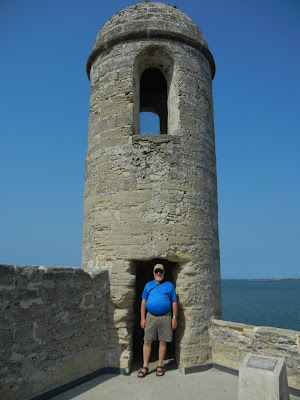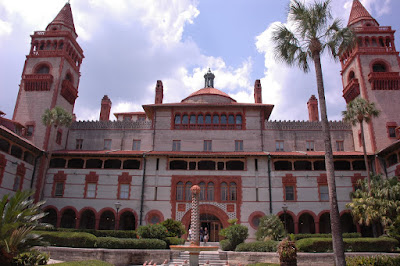First settled in the 16th century by the Spanish, the city we recently left has been under the flags of the Hapsburgs, Bourbon Spain, French, British, Confederacy and United States. It wears its age with charm and beauty. With its narrow roads first used by horses and carriages, we decided the best way to see it was on foot. We were surprised to find many people walking around, visitors, residents, and workers. Parking is limited and the area is small, so walking is efficient.
Our 10K volksmarch took us along quiet lanes filled with historic homes and churches and through busy streets filled with hotels, museums and shops. We passed three cemeteries, Tolomato (Catholic) going back to the 18th century, Huguenot built for non Catholics who died in a plague in 1821, and the National Military where three pyramids hold the remains of over 1500 unknown soldiers of the Seminole Wars.
There we placed stones atop the graves of Jewish soldiers who died over a hundred years ago. We also saw several “oldest” buildings including a house, a school and a drug store and walked along one of the “most beautiful” streets in America.
Walking is a lot of work and deserves a reward. Ours was a tour of Whetstone Chocolate Factory where Chesley, our guide, told us to eat chocolate for our health. We happily complied though we failed to take a drink of the sulfurous water from the Fountain of Youth.
We toured the Spanish Fort Castilla De San Marcos. The fort was built in 1672-95 of coquina, a soft shellrock. A smithy works in his shop, bedframes line the quarters, and the names of men who served are carved into the walls.
Our dinner at Columbia, a Spanish restaurant, was delicious. Jerry relished his seafood paella and Anna Lee enjoyed tapas. The sangria made it all taste even better.
After dinner, we went to the Limelight Theater for The Good Doctor, an enjoyable play written by Neil Simon and based on short stories by Chekhov.
Explorers and colonists may have settled here, but rich entrepreneurs made it a destination. First there was Henry Flagler who turned his Standard Oil fortune into hotel and railroad stock and became the prime leader in developing Florida as a destination for the rich and famous. As the first of his many hotels, Flagler built the Ponce de Leon with Tiffany windows and gilded panels. It is now part of Flagler College.
He, his wife, daughter and grandchild are buried in the mausoleum of the Memorial Presbyterian Church that he also built.
One hundred years later, Chicago magazine magnate Otto Lightner was staying at the luxurious Ponce de Leon Hotel and looked across the street at the decaying Alcazar, another Flagler hotel. He bought it for $50,000 to house his collection of collections. Four floors are filled with glassware, majolica, pipes, cigar wrappers, whatever Victoriana he could lay his hands on. Primarily, he bought other people’s collections during the depression. He kept these in two mansions in Chicago before finding a permanent and beautiful home in a warmer climate. He is buried in the courtyard in front of the building. Here is a small example of the type of items in his collection.
The basement floor, where once swimmers enjoyed the largest indoor pool in the world, now has a fine lunchroom and a series of small antique shops.
The bridge across the Matanzas River took us to the lighthouse and then on to a ferry to Fort Matanzas. This small fort was manned by seven Spanish servicemen who kept the river free from invasion in the mid 1800s.
We must introduce you to our campground neighbor, an alligator, who suns on the edge of the pond right near us and floats in the middle when we get too close.
This lovely town that we so enjoyed is called?










No comments:
Post a Comment